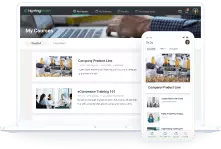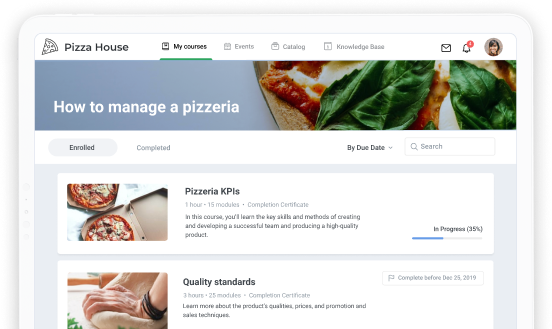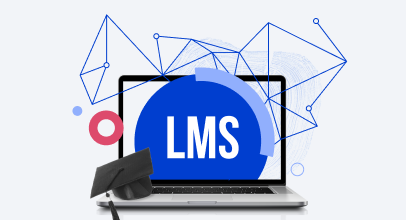15 Top Picks for SaaS LMSs: Keep Your Head in “the Cloud”

Once upon a time, most cars were manual transmission. But now many people drive automatic cars. They both get the job done well, after all, so why spend the extra effort learning to drive stick? Following that same line of reasoning, many people are “shifting gears” from hosted to SaaS learning management systems. They are much easier to implement and use, all while giving you an unparalleled amount of control.
But the more such platforms appear, the more convenient they become, and the more features they offer, the more difficult it is to determine the solution that is right for you. So how do you choose among the countless options?
That’s the question this article aims to answer. Keep reading to find out what SaaS LMSs are, how they differ from hosted LMSs, and our top 15 picks for 2022.
What Is an SaaS LMS?
An SaaS LMS is a learning management system that’s hosted in the cloud rather that a self-hosted, on-site LMS server. In other words, if cyberspace is the sky, you can think of the LMS SaaS as a literal cloud. But instead of hosting and storing water droplets or ice crystals, the “skyberspace” hosts and stores your files and data.
Like the sky (and the clouds within it), the cloud is available to everyone at any time of the day. So if you’re developing training for a team or audience that’s widely distributed, then they’ll be able to easily access your LMS from any place, at any time of the day.
What is a hosted LMS?
Unlike SaaS LMSs, a hosted or self-deployed LMS is not so readily available. Rather than being “in the cloud,” it’s on the ground or “on site.” Hosted LMSs operate via physical servers whose components need to be manually updated and upgraded. With these solutions, you have to manually download and install hardware or software onto your devices. So you’ll likely need to hire IT experts for system maintenance.
SaaS vs. self-hosted LMSs
SaaS stands for “software as a service.” So not only are SaaS LMSs a software application that requires only an internet connection — meaning that anyone, anywhere, can access it any time — but they also provide seamless updates and upgrades across every instance of your platform (past, present, and future). That way, as your business grows and your eLearning content goes out-of-date due to the changing times, your LMS SaaS will ensure that everything keeps pace.
This nicely contrasts with on-premise LMS servers, which not only require consistent architecture across the board — including admin and learner devices — but they also require you to install software and manually tend to any upgrades or updates. This is extra work for your learners, as well as extra manual (paid!) labor for your IT team, especially if there are ever network downtimes or technical failures.
Benefits of an SaaS LMS
As mentioned, an SaaS LMS exists in the cloud. But while these services are out of your hands, they still give admins unrivaled control over the system. No IT team needed! The best part, however, is that it doesn’t matter where your learners are, or what time they decide to log on; they can always access your content.
Now let’s delve further into the benefits of SaaS LMSs.
Ease of course deployment
When running eLearning, creating online courses and other learning materials is just the first step. The second important step is to deliver training courses via an LMS. How simple it will be depends on the system.
With on-premise LMS servers, this trying task is often handled by a sophisticated IT team. With SaaS LMSs, the infrastructure is fully pre-installed and built out for you; all that’s needed from you is to upload your course content.
Extra control over training
If you want more control over how you deliver and manage online training, SaaS platforms are the way to go! At the outset, this might seem counterintuitive. How can they provide extra control while doing the heavy lifting? Well, with no IT task force limiting you to certain tools and integrations, you can easily deliver top-notch training while molding the user experience to your admin and learners’ needs.
Moreover, SaaS LMS providers help users to make sweeping changes across the board, and in just a few clicks. Something as simple as adding Zoom integration for blended learning could require a complete overhaul of an on-premise LMS. So you can see that the ease with which you can make these changes is what gives you extra control over your courses.
Ease of scalability
The more control you have over your training delivery, the easier it will be to move with the tides, thereby making it much easier to scale your business. So if your learner base is rapidly growing, or you need to create a new fleet of courses, no problem! You can simply upgrade to a higher LMS SaaS pricing plan. After all, the best SaaS LMSs help businesses grow in line with their revenue and training needs.
In short, top SaaS LMSs are more flexible and scalable than their physical, on-premise counterparts.
Seamless third-party integrations
Many businesses have CRM, corporate portal, or HR systems that need to be integrated with the LMS. While IT teams are often dedicated to ensuring that on-premise LMS servers play nicely with pre-established company systems, SaaS platforms make this incredibly easy via readily available APIs (application programming interfaces) and integrations. They include user identification, single sign-on (SSO) capabilities, web meeting integrations for blended learning, and many more.
Cost-effectiveness
A lot of people think that on-premise LMSs are more economical than SaaS: hosted LMSs can be typically bought with a one-time payment, while cloud-based systems come with a monthly subscription.
But this logic is flawed. There are many other costs associated with running an on-premise server, including system-wide upgrades to both training content and the LMS itself, fixing network downtime or outages, and even branding. Because even the most basic, low-cost LMS SaaS takes care of all those tedious tasks, you save a lot of time and money.
Top 15 SaaS LMSs
The eLearning market is literally flooded, with over 700 LMS vendors. So to help you avoid drowning in all the options, we’ve compiled a list of 15 top SaaS LMSs for different cases.
1. iSpring Learn

If you’re a business or L&D department looking to train employees, then iSpring Learn has your back. It is a highly intuitive SaaS LMS with powerful functionality. Unlike other alternatives, iSpring Learn also has great content authoring capabilities. It features a built-in course editor that lets your team create quality eLearning in minutes, without leaving their browser. It also comes with an integrated authoring toolkit, iSpring Suite, that enables you to build advanced courses, quizzes, video tutorials, and role-plays, with no learning curve.
Who is it for?
iSpring Learn is a top SaaS LMS for businesses looking to create corporate training (e.g., onboarding, sales, compliance training). Whether you already have course content in a wide variety of multimedia formats or you need an LMS with course authoring capabilities, iSpring Learn is a solid selection.
Key features
- Intuitive interface
- Automated workflows
- Comprehensive and insightful reports
- SCORM-compliant
- A native mobile app
- Learning paths
- Zoom and MS Teams integration
- 360-Degree Performance Appraisal module
2. Canvas

Canvas is an SaaS LMS that’s designed to make teaching and education easier for both the instructor and learner. With its countless school applications and connected community of teachers, its focus is to recreate the typical school and academic environment online.
Who is it for?
Though Canvas LMS SaaS has a version for business, it’s mainly for academic teachers and educators (e.g., high school and higher education).
Key features
- Mobile-friendly and accessible
- A lot of tools and integrations
- Canvas studio for interactive videos
- SCORM capabilities
- Forums and discussion boards
- Large community of educators
3. Docebo

Docebo is an accessible SaaS LMS that automates the entire training process for you, from inception to completion. Its main clientele are big businesses like Coca Cola and the Toronto Blue Jays. It thus offers an impressive range of branding customization options.
Who is it for?
Docebo SaaS LMS is a great product for big and busy businesses that would like to automate training delivery as much as possible and maintain every aspect of their brands.
Key features
- SCORM-compliant
- Social learning features
- 400+ third-party integrations
- Automated employee upskilling and reskilling training
- Robust and easy to use configuration engine
- Accessibility — compliance with WCAG 2.1 AA
4. Blackboard Learn

Used mainly for pedagogical purposes, Blackboard LMS SaaS is known for its ability to infuse teaching with tech in a way that provides instructors full autonomy. Plus, with its user-friendly workflows and the ability to offer personalized support to students, this SaaS LMS platform sets students up for success.
Who is it for?
Blackboard Learn is mainly for academic instructors who would like “faculty freedom,” especially in blended learning environments.
Key features
- Clear and easy-to-monitor learning paths
- Multiple built-in communication channels
- Collaborative integrations
- Built-in course creation tools
- SCORM and xAPI-compliant
5. EdApp

EdApp is an SaaS LMS that functions as a mobile app. Not only does it help you create and deliver microlearning courses, but it also offers a host of free, editable courses, in case you’re tight on time.
Who is it for?
EdApp is great for corporate trainers whose focus is on mobile learning through microlearning.
Key features
- Free course library
- Built-in authoring tool
- PPT to eLearning conversion
- Gamification and social learning features
- Handy Canva integration
6. Looop

Looop differs from the typical SaaS LMS, which generally takes over the training delivery process for you. Instead, it automates the process for employee onboarding and on-demand training with its vast and rich content library. All you have to do is set up the rules and conditions.
Who is it for?
Looop is great for business environments with repetitive corporate training, like compliance and onboarding. If you don’t want to create courses from scratch and would rather have ready-made content to support your training, then Looop’s one of the few SaaS LMSs that do this for you.
Key features
- Learning paths of curated resources
- Real-time, video-based learner testing
- Engagement and ROI analytics on an intuitive dashboard
- A solid set of integrations
- A basic course builder with free templates
7. Skillcast

Skillcast is one of the best SaaS LMSs in the corporate compliance game — namely, ethics and regulatory compliance. That said, because it’s so focused on compliance, you might feel limited if you’re looking for more general workforce training.
Who is it for?
If you’re specifically looking for hands-off compliance training, then Skillcast is a great option.
Key features
- Large library of compliance courses
- HR and CRM APIs and integrations
- Full corporate branding
- SCORM-compliant
- Powerful management reports
8. Guru LMS

Guru is an SaaS platform that offers a breadth of features in terms of creating, delivering, and monetizing your courses. In that way, it’s just as great for corporate training as it is online coaching or tutoring.
Who is it for?
Whether you’re in academics or business, or a freelancer who’d like to sell general courses, Guru offers many features and integrations for automated marketing, branding, and sales.
Key features
- A course and quiz builder
- Videoconferencing capabilities
- Paid courses
- Marketing incentivization methods
- Course completion certificates
- SCORM-compliant
9. LearnUpon

LearnUpon is one of the biggest SaaS LMS vendors for sheer breadth of features. In addition to the regular stuff, like creating, tracking, and delivering eLearning courses, you can also create branded digital storefronts to sell them. But its most distinctive feature is its “learning portals,” which allow you to style and brand each portal based on the audience.
Who is it for?
If you’re a business that doesn’t want to go down the LMS SaaS wormhole, and you have sufficient budget, then LearnUpon is a good option. It has almost everything you’ll need for employee development, customer training, and partner training.
Key features
- Branded digital storefronts
- Audience-specific training via learning portals
- Monetization features
- Completion certificates
- A native mobile app
10. LearnWorlds

If you’re looking for the right balance between high-quality training and monetization, then LearnWorlds is a top SaaS LMS. Its native course authoring tools not only enable a lot of learner interactivity and engagement, but LearnWorlds also provides a powerful sales engine.
Who is it for?
In many cases, these one-size-fits-all eCommerce LMSs skimp on either the learning side or sales side of things. If you’re looking to create high-quality content with high sales conversions, LearnWorlds offers the best of both.
Key features
- Built-in authoring tools
- Great branding customization features
- A built-in social network
- A native mobile app
- A powerful sales engine
11. Litmos

Litmos is a handy LMS SaaS for companies with a user-centric focus. It walks the fine line between sophisticated course creation and efficient course delivery. Not to mention, it offers a large library of off-the-shelf courses. Overall, its focus is on helping businesses with employee learning and development.
Who is it for?
This business-oriented SaaS LMS platform is great for any size of company. While you can create your own courses, you can also refer to its course library to “outsource” repetitive training.
Key features:
- Simple UX-driven design
- Built-in course creation features
- Gamification
- Many integrations and add-ons
- Off-the-shelf courses
12. Crowd Wisdom

If you’re a training manager looking to foster team building and employee growth, then Crowd Wisdom is a popular SaaS LMS choice. Not only does it allow you to deliver a wide range of course types (e.g., microlearning, live training, and webinars), but it’s also easy to arrange and distribute these courses based on personalized employee objectives, competency levels, and learning paths.
Who is it for?
Crowd Wisdom is a good SaaS LMS for professional development training, as opposed to academics. Thus, it’s the perfect solution for training managers who’d like to certify and upskill employees from a wide range of departments.
Key features:
- An easy-to-use interface
- Modern and centralized learning hub
- Third-party webinar integrations
- An assessment engine with multiple question types
- Social community for learners and instructors
13. Qstream

Qstream is another solid SaaS LMS choice if you’re looking for a mobile-first approach to microlearning development for remote employees. This training platform focuses heavily on knowledge retention, skills development, and performance enhancement.
Who is it for?
The Qstream LMS SaaS caters to a wide range of professional industries, including healthcare, food and beverage, law enforcement, and finance. So it’s an excellent option for companies whose learners are in highly regulated and knowledge-intensive industries.
Key features:
- A mobile microlearning app
- Comprehensive reports and analytics
- A built-in testing engine
- A content library to quickly create courses
14. Nimble LMS

Nimble is a partially free SaaS LMS that is easy to set up and use. While its course authoring tool is free, the entire LMS is not. It offers many admin-friendly features to help track trainee progress and performance. Moreover, it offers a marketplace for a wide range of courses, including Healthcare & Safety, Security & Data Protection, and Legislation & Compliance.
Who is it for?
Nimble is one of the best SaaS LMSs for getting your courses to launch quickly. But if you’re looking to leverage their course marketplace for training, then it’s better for businesses.
Key features:
- Efficient reporting and analytics capabilities
- Multi-tiered site administration
- A course marketplace
- Integration with third-party eCommerce plugins
15. Dokeos

Dokeos is a mobile-friendly platform geared toward healthcare, manufacturing, and finance professionals. It helps you integrate any pre-made training into their ready-made modules and offers interesting interactions, including scenario-based quizzes.
Who is it for?
Dokeos is an excellent LMS SaaS for both the educational and professional sectors. That said, if you haven’t yet created content and would like to leverage ready-made courses that can be easily white-labeled and edited, then it offers many more options for businesses.
Key features:
- Customizable learning paths
- Ready-made courses that can be easily edited
- A built-in quiz authoring tool
- Detailed analytics
- eCommerce integrations
How to Choose the Best SaaS LMS
Now that you know what LMSs exist in the modern eLearning market, look at this checklist of how to choose the best solution for your business. Start by asking yourself the following questions:
- Is my course content ready-made, or do I need course authoring capabilities?
- Will my course be published as SCORM packages?
- Is my course fully self-paced, or will there be a synchronous, in-class element?
- Is the SaaS LMS mobile-friendly? Does it offer a native mobile app?
- What types of APIs and third-party integrations will I need?
- Does the SaaS LMS vendor provide insightful reporting and analytics?
 Is my course content ready-made, or do I need course authoring capabilities?
Is my course content ready-made, or do I need course authoring capabilities?
The features and structure of your platform should conform to your content. Let’s say you’ve already developed a series of courses that use the full spectrum of multimedia (e.g., PDFs, text, images, audio, and video). Then you’ll need an LMS that can accommodate these files and their sizes.
That said, if you need an LMS with course creation abilities, then you’ll need to verify that it has the right content authoring features (e.g., a course editor, quiz builder, etc.).
 Will my course be published as SCORM packages?
Will my course be published as SCORM packages?
To keep track of trainee progress and performance, your SaaS LMS system should be compliant with technical eLearning standards like SCORM, xAPI, cmi5, or AICC. The most popular standard that is used by many in the eLearning industry and has widespread support within modern software tools is SCORM. So it’s essential to choose a platform that supports SCORM.
 Is my course fully self-paced or will there be a synchronous, in-class element?
Is my course fully self-paced or will there be a synchronous, in-class element?
While many businesses opt for asynchronous learning, where all training is fully online and self-paced, a lot of others are opting for a combination of online and real-time, face-to-face learning (i.e., blended learning). So you’ll need to be sure your SaaS LMS has the right technology, such as built-in or third-party web conferencing tools, class-scheduling abilities, and so forth.
 Is the SaaS LMS mobile-friendly? Does it offer a native mobile app?
Is the SaaS LMS mobile-friendly? Does it offer a native mobile app?
People are busier than ever before. That’s why one of the major factors in course completion and learner success is convenience and flexibility. Therefore, your LMS should be mobile-friendly. Some of the best SaaS LMS vendors even offer native mobile apps which let employees learn offline.
 What types of APIs and third-party integrations will I need?
What types of APIs and third-party integrations will I need?
When choosing an SaaS LMS provider, look closely at its roster of APIs and integrations. For example, if you plan to market and monetize your courses down the road, you might need to send automated emails using marketing tools like MailChimp. Client management and payment vendor integrations like Stripe might also come in handy—not to mention that if you’re training employees, you’ll likely need tools that help the LMS smoothly integrate with your company’s unique internal systems.
 Does the SaaS LMS vendor provide insightful reporting and analytics?
Does the SaaS LMS vendor provide insightful reporting and analytics?
The ability to analyze learner progress and success across a wide range of metrics is perhaps one of the most important features to look for. That’s why most SaaS LMSs have a reporting and analytics feature. But they’re not all equal. If you train employees, you’ll need key stats about your trainees, their scores, and course completion rates to pinpoint strong and weak areas in your training programs. But if you plan to sell online courses, then you’ll need reports and analytics that measure both sales and learner performance.
Frequently Asked Questions
Here you’ll find the answers to the most popular questions related to training via an LMS.
1. What exactly is an LMS?
A learning management system (LMS) gives instructors or trainers the ability to create and deliver eLearning content under one roof, as well as monitor learner progress and performance.
2. What format should my course content be in?
Your course content can be anything from text or slides-based presentations, videos, quizzes, and SCORM content. Though they can accommodate a wide range of multimedia, to fully take advantage of an LMS’s reporting, tracking, and analytics capabilities it’s best to use SCORM-compliant content.
3. What is SCORM?
The Sharable Content Object Reference Model (SCORM) is an eLearning technical standard that nicely packages interactive content in a way that can be read by an LMS. When this format is used (usually by way of an external authoring tool), not only can you create interactive online courses but your LMS will also be able to unravel and deliver all the sophisticated “fancy features” you’ve added to it.
4. Is it possible to add my own branding and customization?
Absolutely. Many LMSs offer basic branding features and enable you to white-label the site. For example, you can add your own custom domain name, logo, favicon, custom fonts, and color scheme.
Final Thoughts
There’s a reason that the overwhelming majority of LMSs are cloud-based. They give you more control over your training content and delivery, with fewer headaches. That said, one of the biggest headaches is choosing the proper one. We hope this article will help you make the right choice.
But if you’re a business that’s looking to launch your courses in no time, then start your search strong with iSpring Learn’s free 30-day trial.



 Is my course content ready-made, or do I need course authoring capabilities?
Is my course content ready-made, or do I need course authoring capabilities?








